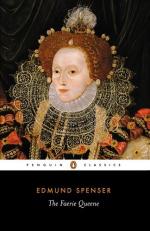2. The religious allegory presents the doctrine, discipline, and spirit of Protestantism in the sixteenth century. A close parallel may be drawn between this canto and many things in Bunyan’s Pilgrim’s Progress. For his House of Holiness and its management, Spenser has no doubt taken many suggestions from the great manor house of some Elizabethan gentleman.
19. AN AUNTIENT HOUSE, the House of Holiness.
28. DAME COELIA, i.e. the Heavenly Lady.
33. FIDELIA AND SPERANZA, Faith and Hope.
35. FAIRE CHARISSA, Charity, or Love. Cf. I Corinthians, xiii, 13.
44. HIGHT HUMILTA, named Humility.
59. AND KNEW HIS GOOD, etc., and knew how to conduct himself to all of every rank.
77. EVER-DYING DREAD, constant dread of death.
78. LONG A DAY, many a long day.
79. THY WEARY SOLES TO LEAD, to guide thy weary feet (to rescue them).
xiii. The description of Fidelia is full of biblical allusions, viz.; her white robe (Revelation, vii, 9); the sacramental cup filled with wine and water according to the custom of the early Christians (John, xix, 34); the serpent symbolical of healing power (Numbers, xxi, and Mark, xiv, 24); the book sealed with the blood of the Lamb (Revelation, v, 1, and II Corinthians, v, 7).
144. ENCREASE is in the optative subj. with God as subject.
172. AND WHEN SHE LIST, etc., and when it pleased her to manifest her higher spiritual power. These miracles of Faith are based on the following passages: Joshua, x, 12; II Kings, xx, 10; Judges, vii, 7; Exodus, xiv, 21; Joshua, iii, 17; Matthew, xxi, 21.
176. This line is given in the folio edition of 1609, but is wanting in the edition of 1590 and 1596.
209. HARDLY HIM INTREAT, scarcely prevail on him.
213. The absolutions granted by the clergy.
215. THE PASSION OF HIS PLIGHT, his suffering condition.
xxx. Percival points out the resemblance between Spenser’s Charity and Andrea del Sarto’s famous painting La Charite in the Louvre.
277. WHOSE PASSING PRICE, etc., whose surpassing value it was difficult to calculate.
292. WELL TO DONNE, well doing, right doing.
318. SEVEN BEAD-MEN, seven men of prayer, corresponding to the Seven Deadly Sins of the House of Pride. They represent good works: (1) entertainment of strangers; (2) food to the needy; (3) clothing to the naked; (4) relief to prisoners; (5) comfort to the sick; (6) burial of the dead, and (7) care of widows and orphans.
354. PRICE OF BRAS, ransom in money. Bras is a Latinism from aes.
355. FROM TURKES AND SARAZINS. In the sixteenth century thousands of Christians were held captive in Turkish and Saracen prisons, and many of these were ransomed by the charitable of Europe. Prescott tells us that Charles V found 10,000 Christians in Tunis at its capture in 1535.




